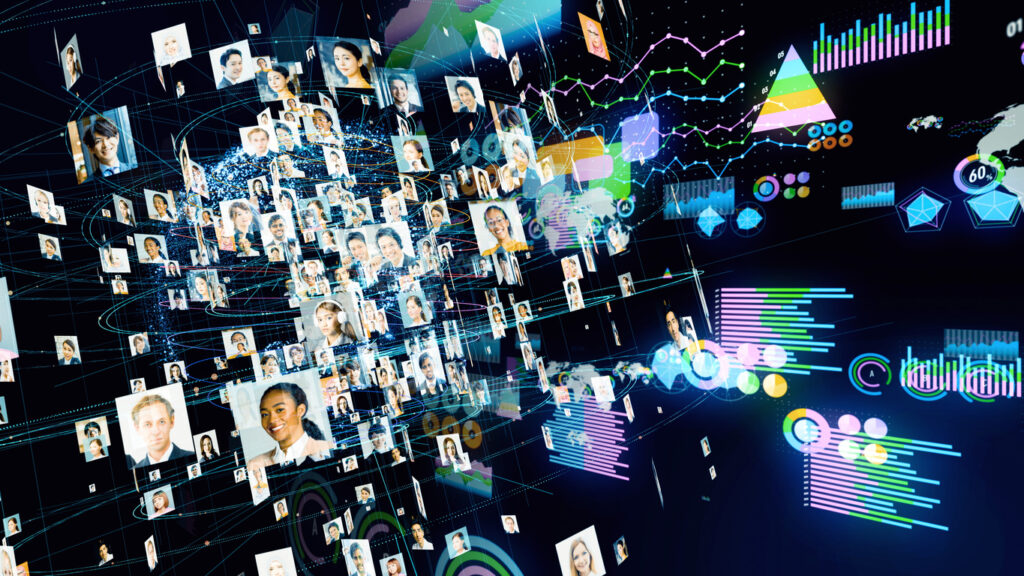In recent years, a growing number of companies have started using people analytics to better understand and manage their workforce – and for good reasons. Employees are a company’s greatest asset and often their largest expense. When supported well, employee performance and productivity can enhance a company’s sustainable competitive advantage.
People analytics is all about using recent digital innovations to derive statistical insights from employee data for modelling and optimising organisational human capital. They allow decision makers to make evidence-based data-driven decisions that make organisations more transparent, fair, efficient, and productive, while allowing the expansion of workers’ opportunities for personal and professional growth.
Innovative people analytics can help HR managers to utilise employee (big) data to make decisions and achieve operational excellence in various HR functions and to improve the full employee lifecycle, resulting in healthier, happier and more productive employees.
Below are five key HR areas in which people analytics can be applied:

1. Talent acquisition
Talent acquisition is a big thing, especially considering the significant consequences it can have for a company. Finding and hiring the right people is a strategic organisational process, with a direct impact on the company’s performance and productivity. A study by the Boston Consulting Group has shown that companies that excel in recruitment enjoy better economic performance.
Yet, this function encompasses a high volume of activity, with inputs, outputs, and processes that are sometimes difficult to detail, so they can be even more difficult to manage or control. Some say that talent acquisition is a straightforward activity; with apparently clear metrics available to measure success like the number of applicants and the number of hires made. Reality, however, is never that simple. How do you attract the best or ideal talent? How do you establish what ‘best’ and ‘ideal’ even look like in the first place? How much should you pay for this talent? And, how do you defend your hiring choices?
People analytics can help by giving insights into what makes an ‘ideal’ employee. By integrating predictive analytics into the recruitment process, algorithms can be trained using historical data to recommend best-fit candidates to hiring managers.
Additionally, people analytics can help companies decide which candidate characteristics should be favoured in the talent acquisition process, how much resource should be deployed for each candidate and how to optimise the entire hiring process. For example, it can help you to decide which screening and selection instruments should be used to rate and whittle down the initial pool of candidates.
People analytics involve a mix of extensive theoretical, statistical, and business knowledge.
A recent study has shown that it is possible to predict the successful placement of a candidate in a specific position at a pre-hire stage and utilise predictions to devise a global optimisation model using a prescriptive analytics approach via Machine Learning and mathematical programming. Ultimately, people analytics can improve common metrics such as time-to-hire and cost-to-hire, as well as quality of hire.
2. Hiring and onboarding
Leveraging the power of people analytics can help organisations to speed up a candidate’s journey to productivity. Onboarding, also known as organisational socialisation, is a vital part of the new employee experience, as it can impact the employee’s initial feelings of belonging, commitment and success. It helps new hires to adjust to the company’s environment so they can feel engaged and prepared for their jobs. When managed effectively, onboarding can result in a faster learning curve for the employee, with a direct impact on organisational productivity.
Interestingly, one does not need to wait until the candidate’s first day to start the onboarding process. Pre-employment assessments can provide an edge in understanding employee strengths and weaknesses, so that actions can be taken well in advance to support employee development. People analytics can help by offering a bespoke onboarding process, designed to meet the needs of each new hire.
For example, if the pre-employment assessment data shows that the new employee is less skilled in problem-solving techniques, then an onboarding plan that includes training in problem analysis and solving can be designed specifically for that employee. The plan can also identify the type and number of resources that will support the candidate more quickly.
3. Training
It’s clear that people analytics can help organisations to deepen their understanding of their workforce. When it comes to training and development, people analytics can also match the capability requirements of the organisation with the learning needs of individual employees. Soft skills, emotional intelligence, and underlying attitudes can also be evaluated and addressed.
Predictive people analytics makes use of Artificial Intelligence and Machine Learning algorithms to help HR practitioners to improve workplace learning, reduce biases in candidate assessment, and retain and motivate existing employees.
For example, prescriptive analytics can suggest a training programme for the employees whose productivity is suffering, so that their performance can be managed, thereby decreasing employee turnover. People analytics can also help score the training and performance outcomes to identify which training programmes produce the strongest results.
Additionally it can help an organisation monitor and enact an objective career progression strategy, one that is based on knowledge, experience, displayed competence and results needed and achieved. In doing so, it can remove an important cause of employee dissatisfaction; feeling unfairly passed over.
4. Engagement and motivation
Employee engagement and motivation is a topic that has received significant attention from practitioners and researchers alike, especially in response to the disruption to the traditional world of work initiated by the pandemic. Questions about where and how employees find meaning in work have fascinated psychologists, sociologists, economists and organisational scholars for decades.
Finding meaning and purpose in the work they do is a deeply personal experience for every employee and there is no such thing as a “standard employee”. Predictive people analytics tools can help not only to measure individual employee experiences in real-time, but also to identify what is driving employee engagement and productivity in the first place, so practices can be adapted to enhance them.
Today, many organisations are embracing people analytics to gain a more holistic view of their business and employee needs, alongside team and individual capabilities.
People analytics can help HR managers to focus on changing the day-to-day experiences that employees have at work and implement actions to enable a more positive, meaningful and productive workplace. It can also help organisations measure their progress against diversity and inclusion goals by providing an objective and data-based framework for analysis and targeted action.
5. Retention
Traditionally, HR analytics have been descriptive in nature which means that past employee data has been generally analysed to identify patterns in metrics such as turnover and retention. Such patterns are then fed into relevant organisational policies aimed at retaining talent.
Descriptive analytics cannot predict future outcomes at an individual employee level, however predictive people analytics can. The advancements in artificial intelligence and machine learning technologies have broadened the capability to perform retention prediction at the individual employee level.
In a talent-based human capital system, organisations need the capability to predict which employees possessing specific skills and talents are most likely to leave. This is vital because if the organisation knows the ‘why’ early enough, it may be able to design timely interventions to improve job satisfaction, offer appropriate incentives, and curb attrition.
This is even more relevant when considering that research has shown that turnover is a context-specific phenomenon. For example, under certain conditions, job attitudes (like satisfaction) might predict turnover better in one context than another. So, it makes sense that each organisation should dedicate resources to building their own models for retention.
Research has shown that common predictor variables of staff attrition include such things as management style, pay and benefits, work-life balance, length of breaks, and performance reviews and promotion, among others.
Predictive people analytics can help to identify the hidden connections between employee satisfaction and other key factors contributing to employee turnover.
[cm_form form_id=’cm_65a14c3f5da64′]
Final thoughts
Today, many organisations are embracing people analytics to gain a more holistic view of their business and employee needs, alongside team and individual capabilities. In turn, such insights can pinpoint strengths and weaknesses and help by indicating where further investment in people is needed.
People analytics involves a mix of extensive theoretical, statistical and business knowledge. Model building goes through various steps and multiple iterations to ensure it fits the data optimally; it also involves a testing step, wherein the model is applied to a real dataset to determine how accurately it can predict actual outcomes.
Done well, these models can optimise recruitment, streamline the onboarding experience, boost training and development, enhance employee engagement and motivation, and reduce staff attrition.
However, it is prudent to acknowledge the limits of the available knowledge and advanced technologies. Because just like with any other advanced statistical models, if approached incorrectly, predictive modelling and people analytics can include a degree of error. Moreover, the predictive models are not the end, only the means to achieve better and more sustainable organisational productivity.
Without human interpretation, judgment, involvement, commitment, common sense, and ethical values, models can be both meaningless and worthless. There is a final step from prediction to action, and when it comes to implementing decisions that can influence employees’ professional and personal lives, the final word in the process must belong to an actual human.






